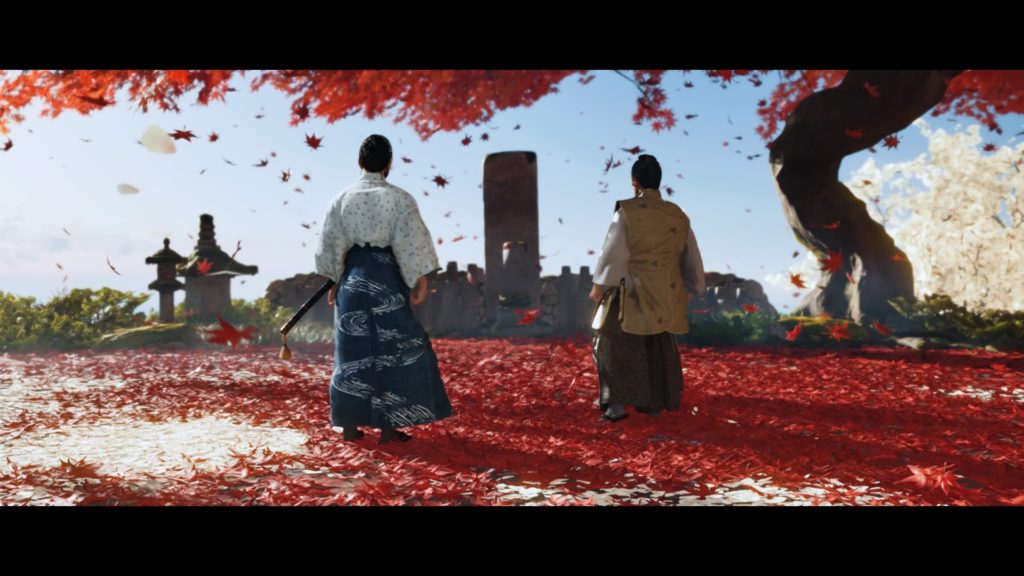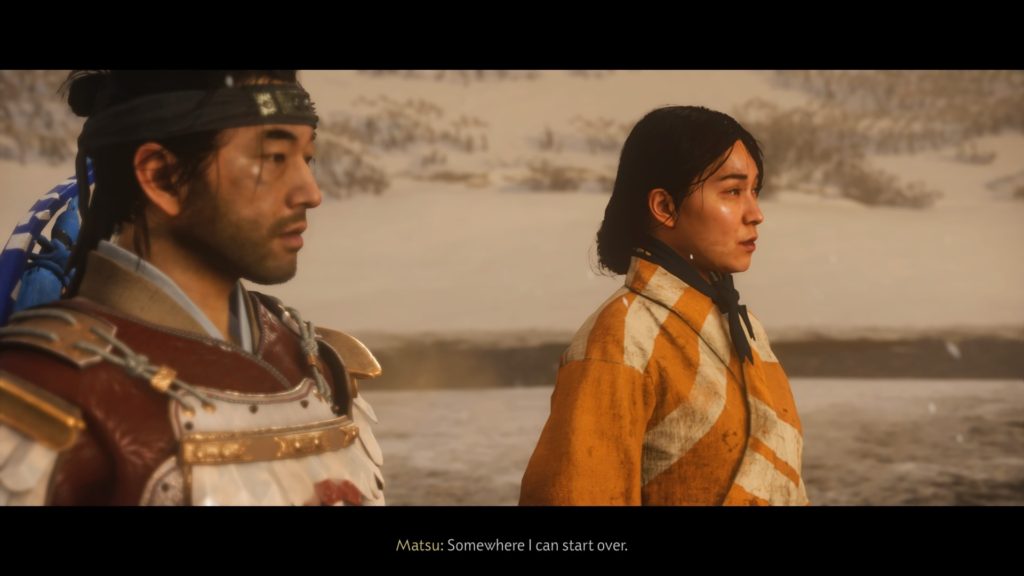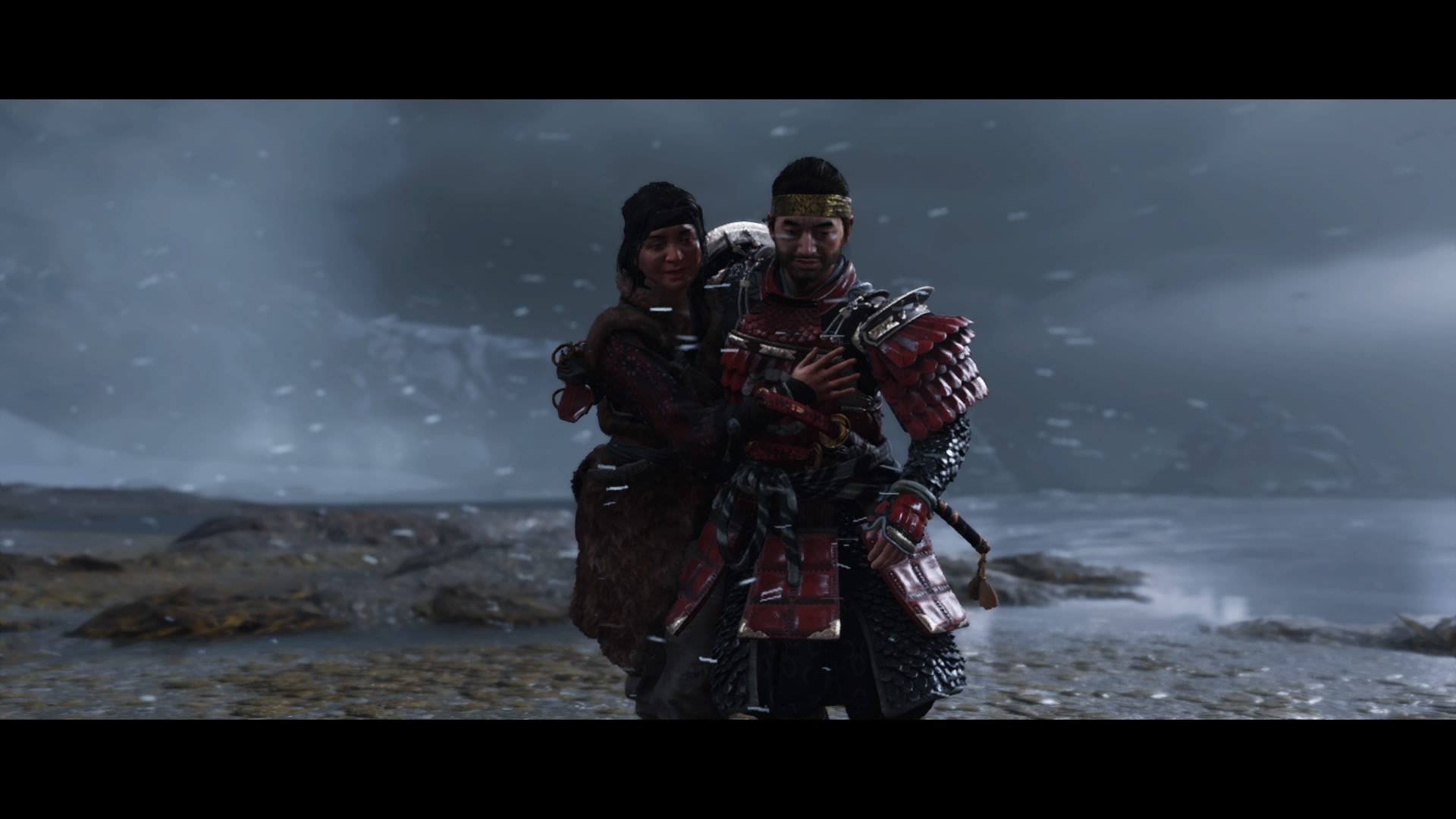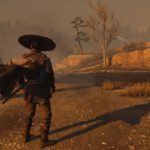Since at least the thumbnail to this post will be shared where people who have not completed Ghost of Tsushima will see it, I headed this with a picture of Jin and Yuna limping together off the battlefield after the final battle with the Khan. But, it was clear from almost the beginning of Act II that this game would not have a happy ending.
In history, the Mongols invaded Tsushima twice. The first time, they swept through the island (which is really quite small), moved on to Iki Island and on to the Japan mainland, where they were beaten back by hundreds of samurai. The second time, they were repelled in Tsushima, and Iki, and an unusual typhoon — the kaze-no-kami, would help the mainlanders drive the Mongols back to Korea. Since this was set during the first Mongol invasion, I fully accepted and expected that Sakai would fall to the Khan.
But this is a game that is not afraid to rewrite history in order to tell its story about what is left when we no longer have family, love, legacy or tradition, and are left with only the drive to do whatever is necessary.

Almost everything I know about samurai I learned from watching Kurosawa movies, and so I imagine I know nothing at all about them. When Shimura and Sakai meet after the final battle, and Shimura says he has been in contact with the shogun and clan Sakai is dissolved, and that Jin himself is an outlaw without clan or honor that is to be killed, I expected Jin to perform seppuku to atone. Jin sat and wrote one final haiku. But Shimura was in agony as well, and dueled the man who was to be his son and heir on the grounds where they’d practiced together so often in flashbacks. The game gives you a final, terrible choice: Kill your uncle with honor after he loses the duel, or let him live with the shame of his loss as you walk away, refusing to end the life of your last connection with your past.

Khotei Khan is one of gaming’s great villains. (Although entirely fictional). He is a monster, but he is a smart monster. When Jin begins to use unconventional tactics for a short term win, he is quick to adopt those same tactics for himself to make his coming attack on the mainland all the more devastating. He isn’t a barbarian warlord. Ordered to occupy Japan by his cousin Kublai, he has spent years studying the Japanese culture, language, and samurai. He knows as much about the bushido culture as Shimura, and he knows how to use it against them.
Sakai is the fly in the ointment. He doesn’t act as samurai are supposed to act. Saved from the rout at Komodo Beach by the thief Yuna, and literally guided by the spirit of his father (who we learn was more similar to Jin than Shimura would ever tell), Jin becomes a supernatural force of vengeance and a human leader of people.

The game introduces new powers and abilities — techniques — at a fairly decent rate. Techniques build upon the various stats of the various armors you gain to make Sakai a one man army, able to stand toe-to-toe to an army (killing five of them outright and terrifying the others), or striking from the shadows, killing the enemy in ones and threes, building the legend of the Ghost as you go.
When you finally come to a decision about whether to treat a defeated enemy with honor or brutality, and make the decision to give up your honor to become a force for terror, you unlock the Ghost Stance. Sakai pays the ultimate blood price for the power to free his homeland.

For all the story, this is still a game, and like all games of this type, there are collectibles and mini-games to break up the flow. I mostly felt the mini-games were tedious, with some exceptions.
- Shrines — these are all jumping puzzles, and can be frustrating at times. They reward gold charms.
- Fox Dens — foxes are the divine messengers from Inari, and typically show up as Sakai is riding to save a village or farm. They almost always break up the flow, but are not as annoying as shrines to get to. They reward lesser charms and increase the number of charms you can equip.
- Bamboo Strikes — these require you to press certain buttons on your controller very quickly. I always found these fun and looked forward to them. They reward resolve points, and are crucial.
- Pillars of Honor — tend to be fairly easy to reach, and reward new looks for your sword kit.
- Haiku Platforms — places where you can rest and write nonsensical haiku while looking over a gorgeous landscape. Takes a super long time and rewards headbands.
- Onsen — pools where you can rest and contemplate your life, while somehow never managing to get your face clean. Rewards increased health.
Resolve was crucial to my build. Since this statistic controls how often you can heal or perform certain special moves, I focused on Resolve, and almost all of my charms went toward regaining this precious statistic. By the end, I could perform many Heavenly Strikes in each boss battle, making many of the duels trivial. Only the extended stages to the Khan fight had me hoarding resolve points to make sure I had sufficient healing to make it through.

When I started this game, I continually compared it to similar games I’d played somewhat recently — Red Dead Redemption 2, Horizon: Zero Dawn, Rise of the Tomb Raider. It is broadly similar in mechanics to all these games, and most especially Tomb Raider. Jin’s character arc is the opposite of RDR2’s Arthur Morgan — Arthur regains his humanity and dies with honor (at least if you played as I did), while Jin loses his humanity and his honor to become a living instrument of terror. HZD’s Aloy keeps expanding her world and experience, while Jin just wants desperately to regain a past that is gone forever. TR’s Lara Croft, of course, lives for the jumping puzzles. She can always rely on herself in a pinch and needs nobody. She’d consider Jin’s moping about a weakness.
Mechanically, the game doesn’t try much that is new. The story, though, is what will ultimately cement this game’s place in RPG history. I’ll definitely be thinking about it for awhile.
Still not understanding why Jin and Yuna never shacked up. Maybe once I finish the epilogue…





I’m glad to see a bit of information about the game in the blogosphere, I’ve had my eye on this game for a bit. It looks incredible, and while I don’t have extensive knowledge about samurai, I do remember a bit about the Bushido code (not sure if that’s what it is called… I’ll need to research it again). I’m glad to have read about the characters through your perspective, and I am curious is Yuna and Jin do get together.
Maybe they’ll get together in a DLC, because they just say “so long”, Jin finishes clearing the island of Mongol camps and then… I just started working on the platinum trophy but there was no plot. Really the only disappointing part to a great game.